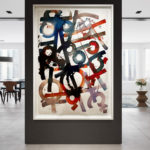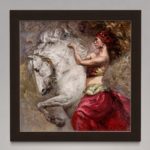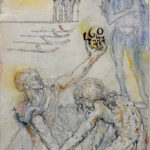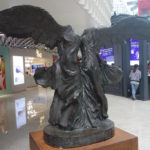An excerpt from an actual email to a family I consult with… By Reed V. Horth for www.robinrile.com
Dear M & J,
First, thank you so much for your kind note about the 60 Minutes special about the present state of the art market, specifically contemporary art. I watched the clip online and I too found it fantastically intriguing. In fact, I have spent the past several years researching art as investment and have worked very hard to locate works as undervalued assets much like real estate speculators do. This is one of the reasons your “Elena III” (by Richard MacDonald) sculpture not only fell into my lap, but was such a good deal versus other examples of the work on the market.
Over the years, I have written a few articles about this subject including “Art as Investment” (https://robinrile.com/blog/?p=263_, “Art and the Keys to Ending Recessions” (https://robinrile.com/blog/?p=1007) and “Giacometti Sculpture sells for $104M” (https://robinrile.com/blog/?p=192). Each article gives a snapshot of the market as a whole, but also provides a bit of background into what differentiates and “investment” piece of art and an “aesthetic” piece of art. While there is not one indicator as to what is or is not “investment-level”, an understanding of both art and the specific trends that differentiate a “good investment” and a “bad investment” is key to located the gems amongst the pebbles. For me, I have generally turned towards locating undervalued assets from tried-and-true names in art (i.e The Big Boys), as opposed to attempting to speculate on undiscovered talent. While unknown artists are often the biggest dividend providers, it is often difficult to sift the wheat from the chaff and once you find a true talent, there is no guarantee that his/her career will flourish beyond the present trend.

Art buyers often look at art for a specific place in the home (i.e. I need a painting above a couch, a sculpture in this corner, etc.) as opposed to looking at art as a long-term investment. If a particular artwork does not suit the present décor, it is often overlooked because of the present aesthetic environment. However, art investors will tend to act much as an National Football League team would do during the NFL Draft, they often chose the best collegiate football player available at the time, and make that athlete fit with them as a player or use him as a tradable asset. Oftentimes, teams will trade draft picks to move up and select a better player simply because they know another team will provide them what they truly need in trade for the drafted player. By the same rationale, investors will not purchase art simply to cover a wall space, but instead purchase a truly great asset once it becomes available because it will be a fungible asset at some point in the future.
While auctions are only one indicator among many to judge artist growth, it does present a barometer of the overall market fluctuations much like the DOW provides you a glimpse of what is going in the US economy but is not the only criteria in which the market is judged. Among the artists whom we have seen auction growth from in the recent past include Salvador Dali, whose prices have an annual growth rate of +116% based on 1,182 lots sold thus far in 2012. Pablo Picasso is up +16% on 2,564 lots. Gerhard Richter is up +161% on 202 lots sold. The overall art market confidence index in pegged at 21.60 and rising [Based on research provided by Artprice.com. The barometer reference point is 0. A positive value reflects an optimistic mood of the market players, pessimism shows below 0. The intraday progression follows up Art Market players feedback on current news (stock market tendencies, geopolitical events, results of high profile sales etc.). This anticipation index is to be correlated with Artprice’s econometrics]
 In fact, on November 4 (2010) at Sotheby’s in New York. Salvador Dali’s 1937 gouache, “Girafe en feu” (Giraffe on Fire), 22-1/4 in. by 30-3/8 in., went on the auction block estimated at $150,000 to $200,000. It finally sold for $1,870,000, a record for any work on paper by the Master Dali. What is more, it’s sale for an astounding 9 times its expected price indicated that we often underestimate the willingness of collectors, and specifically Dali collectors, to back up their passion with their pocket books.
In fact, on November 4 (2010) at Sotheby’s in New York. Salvador Dali’s 1937 gouache, “Girafe en feu” (Giraffe on Fire), 22-1/4 in. by 30-3/8 in., went on the auction block estimated at $150,000 to $200,000. It finally sold for $1,870,000, a record for any work on paper by the Master Dali. What is more, it’s sale for an astounding 9 times its expected price indicated that we often underestimate the willingness of collectors, and specifically Dali collectors, to back up their passion with their pocket books.
What one must also look at is the growth or contraction of specific genres of art, whether in be modern art, pre-Colombian pottery, Ancient Chinese rice paper drawings, Contemporary, 19-20th Century Impressionist, Post-war, Latin-American, Ashcan School, etc. Like fine Italian or French wines, each genre is a discipline in-and-of itself, and must be measured on its own scale. All art cannot be compared to the market as a whole with the possible exception of market surges and crashes where everything is affected. Each must be taken of its own merit and limitation, specifically given the particular time frame in which we live and collect. After the unprecedented market expansion of the 1950s and 1960s, the oil crisis of 1973 dramatically stymied the art market and all movements of art took many years to recover. Art Basel (Switzerland) suffered its first market losses in 1974 as a direct result of this upheaval. The 1980’s boom of the Asian buying markets, and the commensurate competitive urges of the West, saw a 600% increase in the prices of artworks both in private sale and in auctions. This boom hit a speed bump in the early 1990’s with the first Persian Gulf war and did not recover again till the 1997 sale of Victor & Sally Ganz’s world-class collection of 20th Century masterworks including Pablo Picasso’s “La rêve” to Las Vegas mogul Steve Wynn for a then-record price of $49M. Less than 10 years later, Wynn had a sale lined up for “La rêve” of $139M which was only halted when he accidentally damaged the painting while showing it to friends. (He put his elbow through one corner of the painting, as his eyesight is quite poor. The post-operative valuation caused it to lose nearly $54M in salable value. Ugh!)
Since 2009, our faith has been rekindled in the art market as sales have an upward trend with continue a record-setting pace on the upper echelons of collecting and steadily ascending prices on the mid-range to high-range collections ($50k+). Collectors with investments in a diversified range of assets and funds, have turned to art as a commodity which not only holds value, but also as a hedge against the volatility of the markets. Further, the aesthetic pleasure and status-gaining symbology of art is hard to overlook. While perhaps not as liquid as stock-related investments, art has trended strongly depending on the types of works a investor chooses, the quickness in which they act on opportunities and their ability and desire to hold art assets long-term. Low-range ($100.-$20,000.) continues to be a difficult pricing range as collectors in this bracket tend to hold their money or invest in other speculative markets.
This all being said, depending on what type, style, genre, or motivation the buyer happens to have, whether it is historical, speculative, aesthetic or some amalgam of each, we work to determine what the best “draft picks” are on the market at any given time.
In fact, we have a few that we feel are great draft picks as we speak.








